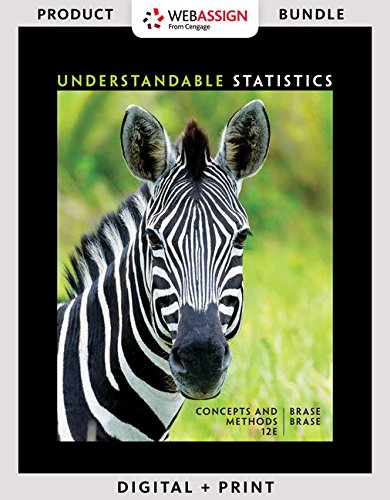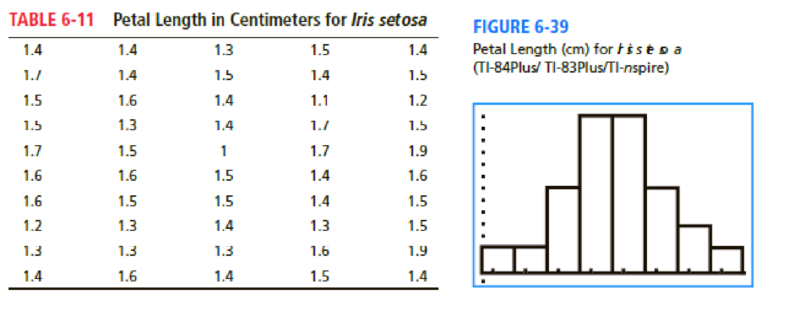
Concept explainers
Break into small groups and discuss the following topics. Organize a brief outline in which you summarize the main points of your group discussion.
Iris setosa is a beautiful wildflower that is found in such diverse places as Alaska, the Gulf of St. Lawrence, much of North America, and even in English meadows and parks. R. A. Fisher, with his colleague Dr. Edgar Anderson, studied these flowers extensively. Dr. Anderson described how he collected information on irises:
I have studied such irises as I could get to see, in as great detail as possible, measuring iris standard after iris standard and iris fall after iris fall, sitting squat-legged with record book and ruler in mountain meadows, in cypress swamps, on lake beaches, and in English parks. [E. Anderson, “The Irises of the Gaspé Peninsula,” Bulletin, American Iris Society, Vol. 59 pp. 2–5, 1935.]
The data in Table 6-11 were collected by Dr. Anderson and were published by his friend and colleague R. A. Fisher in a paper titled “The Use of Multiple Measurements in Taxonomic Problems” (Annals of Eugenics, part II, pp. 179–188, 1936). To find these data, visit the Carnegie Mellon University Data and Story Library (DASL) web site. From the DASL site, look under Biology and Wild iris select Fisher's Irises Story.
Let x be a random variable representing petal length. Using a TI-84Plus/ TI-83Plus/TI-nspire calculator, it was found that the sample mean is
- (a) Examine the histogram for petal lengths. Would you say that the distribution is approximately mound-shaped and symmetric? Our sample has only 50 irises; if many thousands of irises had been used, do you think the distribution would look even more like a normal curve? Let x be the petal length of Iris setosa. Research has shown that x has an approximately
normal distribution , with mean μ = 1.5 cm and standard deviation σ = 0.2 cm. - (b) Use the
empirical rule with μ = 1.5 and σ = 0.2 to get an interval into which approximately 68% of the petal lengths will fall. Repeat this for 95% and 99.7%. Examine the raw data and compute the percentage of the raw data that actually fall into each of these intervals (the 68% interval, the 95% interval, and the 99.7% interval). Compare your computed percentages with those given by the empirical rule. - (c) Compute the probability that a petal length is between 1.3 and 1.6 cm. Compute the probability that a petal length is greater than 1.6 cm.
- (d) Suppose that a random sample of 30 irises is obtained. Compute the probability that the average petal length for this sample is between 1.3 and 1.6 cm. Compute the probability that the average petal length is greater than 1.6 cm.
- (e) Compare your answers to parts (c) and (d). Do you notice any differences? Why would these differences occur?

(a)
Explain whether the distribution is approximately mound-shaped and symmetrical.
Answer to Problem 1DH
Yes, the distribution is approximately mound-shaped and symmetrical.
Explanation of Solution
From the histogram for petal lengths, the distribution is approximately bell-shaped or mound-shaped and symmetrical because approximately the left half of the graph is the mirror image of the right half of the graph.
Our sample has only 50 irises; if many thousands of irises had been used, the distribution would look more similar to a normal curve because the sample is very large and the distribution of the sample will be approximately normally distributed.
(b)
Obtain the 68%, 95%, and 99% interval and compare the computed percentages with those given by the empirical rule.
Answer to Problem 1DH
The 68%, 95%, and 99% intervals are (1.3, 1.7), (1.1, 1.9), and (0.9, 2.1), respectively.
Explanation of Solution
Let x be the petal length of Iris Setosa and x has an approximately normal distribution, with mean
It is known that 68% of the observations will fall within one standard deviation of mean.
The 68% interval is as follows:
The 95% of the observations will fall within two standard deviations of mean.
The 95% interval is as follows:
The 99.7% of the observations will fall within two standard deviations of mean.
The 99.7% interval is as follows:
The 33 observations fall within the intervals 1.3 and 1.7;thus, the percentage of data within the intervals 1.3 and 1.7 is
The 46 observations fall within the intervals 1.1 and 1.9;thus, the percentage of data within the intervals 1.3 and 1.7 is
All data values fall within the intervals 0.9 and 2.1;thus, the percentage of data within the intervals 1.3 and 1.7 is
(c)
Obtain the probability that a petal length is between 1.3 and 1.6 cm and the probability that a petal length is greater than 1.6 cm.
Answer to Problem 1DH
The probability that a petal length is between 1.3 and 1.6 cm is 0.5328.
The probability that a petal length is greater than 1.6 cm is 0.3085.
Explanation of Solution
Let x be the petal length of Iris Setosa and x has an approximately normal distribution, with mean
The interval
The z-score for
The z-score for
The probabilitythat a petal length is between 1.3 and 1.6 cm is obtained as shown below:
In Appendix II, Table 5: Areas of a Standard Normal Distribution.
The values of
The probability corresponding to 0.5 is 0.6915 and the probability corresponding to -1 is 0.1587.
Hence, the probability that a petal length is between 1.3 and 1.6 cm is 0.5328.
The z-score for
The probability that a petal length is greater than 1.6 cm is obtained as given below:
Using Table 5 from the Appendix, the probability corresponding to 0.5 is 0.6915.
Hence, the probability that a petal length is greater than 1.6 cm is 0.3085.
(d)
Obtain the probability that the average petal length is between 1.3 and 1.6 cm and the probability that the average petal length is greater than 1.6 cm.
Answer to Problem 1DH
The probability that the average petal length is between 1.3 and 1.6 cm is 0.9972.
The probability that the averagepetal length is greater than 1.6 cm is 0.0027.
Explanation of Solution
Let x be the petal length of Iris Setosa and x has an approximately normal distribution, with mean
With sample size as n = 30, the sampling distribution for
The interval
The z-score for
The z-score for
The probability that the average petal length is between 1.3 and 1.6 cm is obtained as shown below:
In Appendix II, Table 5: Areas of a Standard Normal Distribution.
The values of
The probability corresponding to 2.78 is 0.9973 and the probability corresponding to -5.55does exist; Thus, it is considered as 0.0001.
Hence, the probability that the average petal length is between 1.3 and 1.6 cm is 0.9972.
The z-score for
The probability that the average petal length is greater than 1.6 cm is obtained as given below:
Using Table 5 from the Appendix, the probability corresponding to 2.78 is 0.9973.
Hence, the probability that the average petal length is greater than 1.6 cm is 0.0027.
(e)
Compare the results of Part (c) and Part (d); also delineate the differences.
Answer to Problem 1DH
The standard deviation of the sample mean is much smaller than the population standard deviation.
Explanation of Solution
In Part (c), x has a distribution that is approximately normal with
In Part (d),
The central limit theorem tells us that the standard deviation of the sample mean is much smaller than the population standard deviation.
Want to see more full solutions like this?
Chapter 6 Solutions
Bundle: Understandable Statistics: Concepts And Methods, 12th + Jmp Printed Access Card For Peck's Statistics + Webassign Printed Access Card For ... And Methods, 12th Edition, Single-term
 MATLAB: An Introduction with ApplicationsStatisticsISBN:9781119256830Author:Amos GilatPublisher:John Wiley & Sons Inc
MATLAB: An Introduction with ApplicationsStatisticsISBN:9781119256830Author:Amos GilatPublisher:John Wiley & Sons Inc Probability and Statistics for Engineering and th...StatisticsISBN:9781305251809Author:Jay L. DevorePublisher:Cengage Learning
Probability and Statistics for Engineering and th...StatisticsISBN:9781305251809Author:Jay L. DevorePublisher:Cengage Learning Statistics for The Behavioral Sciences (MindTap C...StatisticsISBN:9781305504912Author:Frederick J Gravetter, Larry B. WallnauPublisher:Cengage Learning
Statistics for The Behavioral Sciences (MindTap C...StatisticsISBN:9781305504912Author:Frederick J Gravetter, Larry B. WallnauPublisher:Cengage Learning Elementary Statistics: Picturing the World (7th E...StatisticsISBN:9780134683416Author:Ron Larson, Betsy FarberPublisher:PEARSON
Elementary Statistics: Picturing the World (7th E...StatisticsISBN:9780134683416Author:Ron Larson, Betsy FarberPublisher:PEARSON The Basic Practice of StatisticsStatisticsISBN:9781319042578Author:David S. Moore, William I. Notz, Michael A. FlignerPublisher:W. H. Freeman
The Basic Practice of StatisticsStatisticsISBN:9781319042578Author:David S. Moore, William I. Notz, Michael A. FlignerPublisher:W. H. Freeman Introduction to the Practice of StatisticsStatisticsISBN:9781319013387Author:David S. Moore, George P. McCabe, Bruce A. CraigPublisher:W. H. Freeman
Introduction to the Practice of StatisticsStatisticsISBN:9781319013387Author:David S. Moore, George P. McCabe, Bruce A. CraigPublisher:W. H. Freeman





